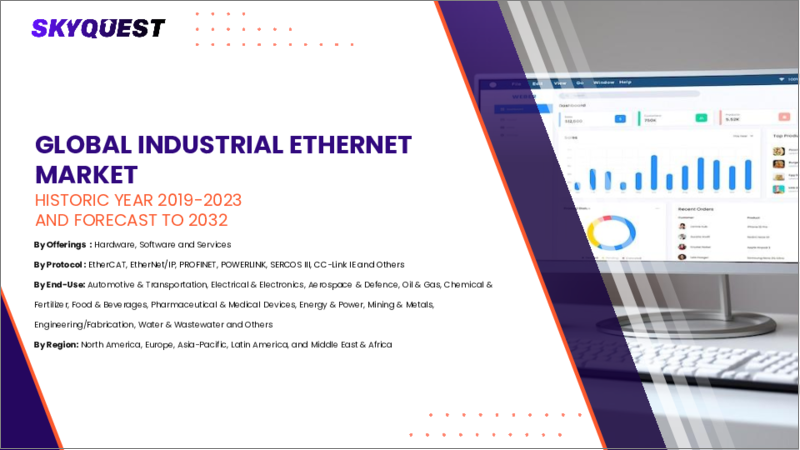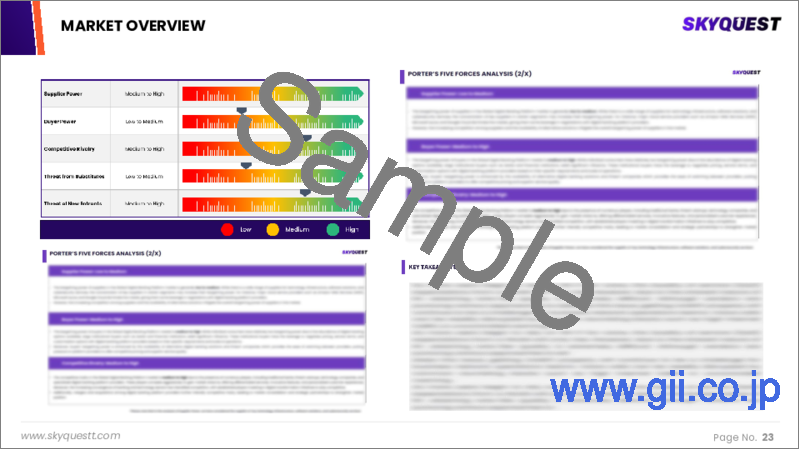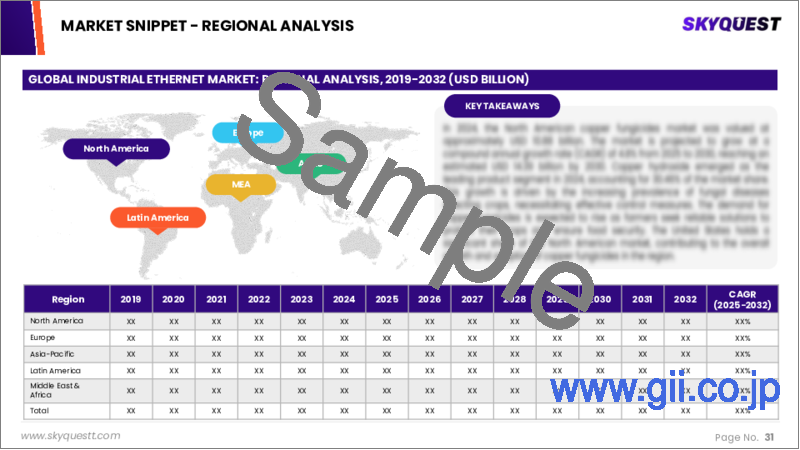|
|
市場調査レポート
商品コード
1603379
産業用イーサネットの市場規模、シェア、成長分析、オファリング別、プロトコル別、最終用途別、地域別 - 産業予測、2024年~2031年Industrial Ethernet Market Size, Share, Growth Analysis, By Offerings (Hardware, Software), By Protocol (EtherCAT, EtherNet/IP), By End-use (Automotive & Transportation, Electrical & Electronics), By Region - Industry Forecast 2024-2031 |
||||||
|
|||||||
| 産業用イーサネットの市場規模、シェア、成長分析、オファリング別、プロトコル別、最終用途別、地域別 - 産業予測、2024年~2031年 |
|
出版日: 2024年11月25日
発行: SkyQuest
ページ情報: 英文 223 Pages
納期: 3~5営業日
|
全表示
- 概要
- 目次
産業用イーサネットの世界市場規模は2022年に73億米ドルと評価され、予測期間(2024-2031年)のCAGRは34.22%を示し、2023年の106億6,000万米ドルから2031年には1,123億米ドルに成長すると予測されています。
世界の航空業界は、技術の進歩とデータの普及に煽られて変革期を迎えており、市場成長を顕著に促進しています。主な促進要因としては、産業オートメーション化の動向やネットワーク技術の急速な進歩が挙げられます。費用対効果への投資の増加、データ収集と分析への注目の高まりが、収益成長をさらに促進しています。産業用イーサネットネットワークは、このような状況において極めて重要であり、多様なセンサーやデバイスからの膨大なデータの集約を可能にします。このようなネットワークは、費用対効果が高まるにつれて、従来のフィールドバスシステムを凌駕し、さまざまな産業用アプリケーションで人気を博しています。しかし、業界は、初期設定コストの高さ、導入のハードル、相互運用性の問題など、全体的な収益拡大を妨げる課題に直面しています。こうした障害にもかかわらず、産業用イーサネットネットワークは、ギガビット・イーサネットによる最大1Gビット/秒のデータ速度、有線・無線通信の両方に対応する標準的なネットワーク・ハードウェアとの互換性、相互運用性の向上、光ファイバーを利用した長距離通信の柔軟性など、他の産業用ネットワーク・タイプと比較して大きな利点を備えています。さらに、光ファイバー・イーサネット・ソリューションを採用することで、電気的ノイズの懸念が軽減されるとともに、必要不可欠な電気的絶縁が提供されるため、自動化プロセスや制御システムの信頼性が高まります。その結果、従来のイーサネット・プロトコルと産業用アプリケーションの融合は、航空部門に革命をもたらし、より効率的でコスト効果の高い運用フレームワークへの道を開くことになります。
目次
イントロダクション
- 調査の目的
- 調査範囲
- 定義
調査手法
- 情報調達
- 二次データと一次データの方法
- 市場規模予測
- 市場の前提条件と制限
エグゼクティブサマリー
- 世界市場の見通し
- 供給と需要の動向分析
- セグメント別機会分析
市場力学と見通し
- 市場概要
- 市場規模
- 市場力学
- 促進要因と機会
- 抑制要因と課題
- ポーター分析と影響
- 競争企業間の敵対関係
- 代替品の脅威
- 買い手の交渉力
- 新規参入業者の脅威
- 供給企業の交渉力
主な市場の考察
- 重要成功要因
- 競合の程度
- 主な投資機会
- 市場エコシステム
- 技術の進歩
- 規制情勢
- バリューチェーン分析
- ケーススタディ分析
- PESTEL分析
- マクロ経済指標
- 市場の魅力指数
- 価格分析
産業用イーサネットの市場規模:オファリング別& CAGR(2024-2031)
- ハードウェア
- ソフトウェア
- サービス
産業用イーサネットの市場規模:プロトコル別& CAGR(2024-2031)
- イーサキャット
- イーサネット/IP
- プロフィネット
- パワーリンク
- セルコスIII
- CC-Link IE
- その他
産業用イーサネットの市場規模:最終用途別& CAGR(2024-2031)
- 自動車・輸送
- 電気・電子
- 航空宇宙・防衛
- 石油・ガス
- 化学薬品・肥料
- 食品・飲料
- 医薬品・医療機器
- エネルギー・電力
- 鉱業・金属
- エンジニアリング/製造
- 水と廃水
- その他
- 紙・パルプ
- ガラス
- セメント
産業用イーサネットの市場規模:地域別& CAGR(2024-2031)
- 北米
- 米国
- カナダ
- 欧州
- 英国
- ドイツ
- スペイン
- フランス
- イタリア
- その他欧州地域
- アジア太平洋
- 中国
- インド
- 日本
- 韓国
- その他アジア太平洋地域
- ラテンアメリカ
- ブラジル
- その他ラテンアメリカ地域
- 中東およびアフリカ
- GCC諸国
- 南アフリカ
- その他中東・アフリカ
競合情報
- 上位5社の比較
- 主要企業の市場ポジショニング(2023年)
- 主な市場企業が採用した戦略
- 市場の最近の動向
- 企業の市場シェア分析(2023年)
- 主要企業の企業プロファイル
- 会社概要
- 製品ポートフォリオ分析
- セグメント別シェア分析
- 収益の前年比比較(2021-2023)
主要企業プロファイル
- Cisco Systems, Inc.
- Siemens
- Rockwell Automation
- OMRON Corporation
- Moxa Inc.
- Phoenix Contact
- Belden Inc.
- ABB
- Schneider Electric
- Bosch Rexroth AG
- Analog Devices Inc.
- Beckhoff Automation
- Robert Bosch GmbH
- Hitachi Ltd
- GE Grid Solutions
- Advantech
- HMS Networks
- IFM Electronic
- Weidmuller
- Patton
結論と推奨事項
Global Industrial Ethernet Market size was valued at USD 7.3 billion in 2022 and is projected to grow from USD 10.66 billion in 2023 to USD 112.3 billion by 2031, exhibiting a CAGR of 34.22% during the forecast period (2024-2031).
The global aviation industry is undergoing a transformative shift fueled by advancements in technology and the proliferation of data, which are notably enhancing market growth. Key drivers include the trend towards industrial automation and rapid advancements in networking technologies. Increased investments in cost-effectiveness, along with a heightened focus on data collection and analysis, are further propelling revenue growth. Industrial Ethernet networks are pivotal in this landscape, enabling the aggregation of vast data from diverse sensors and devices, which can then be analyzed to bolster operational efficiency and informed decision-making. As these networks become increasingly cost-effective, they surpass traditional fieldbus systems, gaining traction in various industrial applications. However, the industry faces challenges such as high initial setup costs, implementation hurdles, and interoperability issues that hinder overall revenue expansion. Despite these obstacles, Industrial Ethernet networks offer significant advantages over other industrial network types, including data speeds of up to 1 Gbit/s through Gigabit Ethernet, compatibility with standard networking hardware for both wired and wireless communication, enhanced interoperability, and the flexibility to utilize optical fiber for extended distances. Additionally, employing fiber-optic Ethernet solutions mitigates electrical noise concerns while providing essential electrical isolation, thus ensuring more reliable automated processes and control systems. Consequently, the blending of traditional Ethernet protocols with industrial applications stands to revolutionize the aviation sector, paving the way for a more efficient and cost-effective operational framework.
Top-down and bottom-up approaches were used to estimate and validate the size of the Global Industrial Ethernet market and to estimate the size of various other dependent submarkets. The research methodology used to estimate the market size includes the following details: The key players in the market were identified through secondary research, and their market shares in the respective regions were determined through primary and secondary research. This entire procedure includes the study of the annual and financial reports of the top market players and extensive interviews for key insights from industry leaders such as CEOs, VPs, directors, and marketing executives. All percentage shares split, and breakdowns were determined using secondary sources and verified through Primary sources. All possible parameters that affect the markets covered in this research study have been accounted for, viewed in extensive detail, verified through primary research, and analyzed to get the final quantitative and qualitative data.
Global Industrial Ethernet Market Segmental Analysis
Global Industrial Ethernet Market is segmented by Offerings, by Protocol, by End-use, and by Region. Based on Offerings, the market is segmented into Hardware, Software, and Services. Based on Protocol, the market is segmented into EtherCAT, EtherNet/IP, Profinet, Powerlink, Sercos III, CC-Link IE, and Others. Based on End Use, the market is segmented into Automotive & Transportation, Electrical & Electronics, Aerospace & Defense, Oil & Gas, Chemical & Fertilizer, Food & Beverages, Pharmaceutical & Medical Devices, Energy & Power, Mining & Metals, Engineering/Fabrication, Water & Wastewater, and Others. Based on region, the market is segmented into North America, Europe, Asia Pacific, Latin America and Middle East & and Africa.
Driver of the Global Industrial Ethernet Market
The global industrial Ethernet market is experiencing significant growth due to the rising adoption of Industry 4.0 technologies. This transformative approach emphasizes the integration of cutting-edge innovations such as automation, Internet of Things (IoT), artificial intelligence (AI), and big data analytics, all aimed at boosting productivity and operational efficiency in various industrial sectors. Industrial Ethernet serves as the crucial connectivity framework needed to facilitate these technologies, allowing for seamless real-time data exchange, remote monitoring, and control. This connectivity not only enhances operational effectiveness but also minimizes downtime, positioning industrial Ethernet as an essential component in the evolution of modern industrial processes.
Restraints in the Global Industrial Ethernet Market
One of the key challenges facing the global industrial Ethernet market is the substantial costs involved in implementing these networks. The process of establishing the necessary infrastructure, acquiring hardware components, deploying software solutions, and prioritizing network security can lead to hefty financial investments. This financial burden can be particularly daunting for small and medium-sized enterprises (SMEs), which often operate under stringent budgetary constraints. As a result, these SMEs may find it difficult to embrace industrial Ethernet technologies, consequently hindering overall market growth and limiting wider adoption among potential users.
Market Trends of the Global Industrial Ethernet Market
A significant trend shaping the global industrial Ethernet market is the surging demand for integrating Industrial Internet of Things (IIoT) technologies. As industries strive to enhance operational efficiency, predictive maintenance, and data-driven decision-making, the necessity for robust, high-speed networking solutions becomes paramount. Industrial Ethernet networks are pivotal, providing the seamless connectivity crucial for IIoT deployment. This combination facilitates real-time data exchange, remote monitoring, and advanced control systems, ultimately driving substantial operational efficiencies and minimizing downtime. As companies across various sectors undergo digital transformations to harness IIoT capabilities, the global industrial Ethernet market is poised for substantial growth, reflecting a trend toward increased automation and connectivity.
Table of Contents
Introduction
- Objectives of the Study
- Scope of the Report
- Definitions
Research Methodology
- Information Procurement
- Secondary & Primary Data Methods
- Market Size Estimation
- Market Assumptions & Limitations
Executive Summary
- Global Market Outlook
- Supply & Demand Trend Analysis
- Segmental Opportunity Analysis
Market Dynamics & Outlook
- Market Overview
- Market Size
- Market Dynamics
- Driver & Opportunities
- Restraints & Challenges
- Porters Analysis & Impact
- Competitive rivalry
- Threat of substitute
- Bargaining power of buyers
- Threat of new entrants
- Bargaining power of suppliers
Key Market Insights
- Key Success Factors
- Degree of Competition
- Top Investment Pockets
- Market Ecosystem
- Technological Advancement
- Regulatory Landscape
- Value Chain Analysis
- Case Study Analysis
- PESTEL Analysis
- Macro-Economic Indicators
- Market Attractiveness Index
- Pricing Analysis
Global Industrial Ethernet Market Size by Offerings & CAGR (2024-2031)
- Hardware
- Software
- Services
Global Industrial Ethernet Market Size by Protocol & CAGR (2024-2031)
- EtherCAT
- EtherNet/IP
- PROFINET
- POWERLINK
- SERCOS III
- CC-Link IE
- Others
Global Industrial Ethernet Market Size by End-use & CAGR (2024-2031)
- Automotive & Transportation
- Electrical & Electronics
- Aerospace & Defense
- Oil & Gas
- Chemical & Fertilizer
- Food & Beverages
- Pharmaceutical & Medical Devices
- Energy & Power
- Mining & Metals
- Engineering/Fabrication
- Water & Wastewater
- Others
- Paper & Pulp
- Glass
- Cement
Global Industrial Ethernet Market Size by Region & CAGR (2024-2031)
- North America, (by Offerings, by Protocol, by End-use)
- US
- Canada
- Europe, (by Offerings, by Protocol, by End-use)
- UK
- Germany
- Spain
- France
- Italy
- Rest of Europe
- Asia-Pacific, (by Offerings, by Protocol, by End-use)
- China
- India
- Japan
- South Korea
- Rest of Asia Pacific
- Latin America, (by Offerings, by Protocol, by End-use)
- Brazil
- Rest of Latin America
- Middle East & Africa, (by Offerings, by Protocol, by End-use)
- GCC Countries
- South Africa
- Rest of Middle East & Africa
Competitive Intelligence
- Top 5 Player Comparison
- Market Positioning of Key Players, 2023
- Strategies Adopted by Key Market Players
- Recent Developments in the Market
- Company Market Share Analysis, 2023
- Company Profiles of All Key Players
- Company Details
- Product Portfolio Analysis
- Company's Segmental Share Analysis
- Revenue Y-O-Y Comparison (2021-2023)
Key Company Profiles
- Cisco Systems, Inc.
- Company Overview
- Business Segment Overview
- Financial Updates
- Key Developments
- Siemens
- Company Overview
- Business Segment Overview
- Financial Updates
- Key Developments
- Rockwell Automation
- Company Overview
- Business Segment Overview
- Financial Updates
- Key Developments
- OMRON Corporation
- Company Overview
- Business Segment Overview
- Financial Updates
- Key Developments
- Moxa Inc.
- Company Overview
- Business Segment Overview
- Financial Updates
- Key Developments
- Phoenix Contact
- Company Overview
- Business Segment Overview
- Financial Updates
- Key Developments
- Belden Inc.
- Company Overview
- Business Segment Overview
- Financial Updates
- Key Developments
- ABB
- Company Overview
- Business Segment Overview
- Financial Updates
- Key Developments
- Schneider Electric
- Company Overview
- Business Segment Overview
- Financial Updates
- Key Developments
- Bosch Rexroth AG
- Company Overview
- Business Segment Overview
- Financial Updates
- Key Developments
- Analog Devices Inc.
- Company Overview
- Business Segment Overview
- Financial Updates
- Key Developments
- Beckhoff Automation
- Company Overview
- Business Segment Overview
- Financial Updates
- Key Developments
- Robert Bosch GmbH
- Company Overview
- Business Segment Overview
- Financial Updates
- Key Developments
- Hitachi Ltd
- Company Overview
- Business Segment Overview
- Financial Updates
- Key Developments
- GE Grid Solutions
- Company Overview
- Business Segment Overview
- Financial Updates
- Key Developments
- Advantech
- Company Overview
- Business Segment Overview
- Financial Updates
- Key Developments
- HMS Networks
- Company Overview
- Business Segment Overview
- Financial Updates
- Key Developments
- IFM Electronic
- Company Overview
- Business Segment Overview
- Financial Updates
- Key Developments
- Weidmuller
- Company Overview
- Business Segment Overview
- Financial Updates
- Key Developments
- Patton
- Company Overview
- Business Segment Overview
- Financial Updates
- Key Developments





